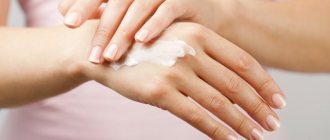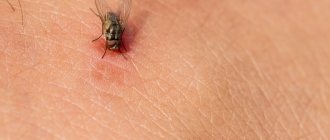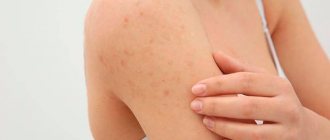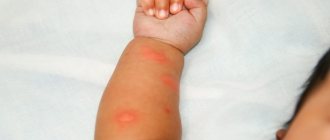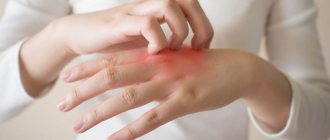Last update: 02/20/2021
Author of the article: pediatrician Valentina Razheva
In everyday life, we come into contact with a huge number of allergens, sometimes without even knowing it. And it goes without saying that the least protected areas of the skin take the blow. We are talking about the hands with which we wash dishes and do cleaning, grab snowballs in winter, forgetting about gloves, and rarely apply sunscreen in summer. But in addition to external irritants, there are many other reasons why allergies occur on the skin of the hands.
Causes of hand skin allergies
- Prolonged or regular contact of unprotected hands with household chemicals. Modern detergents contain active, strong chemicals, especially bleaches and plumbing cleaners.
- Allergies on the palms can also occur when using inappropriate cosmetics: low-quality soap or cream that contains allergenic components.
- Long-term use of medications, especially antibiotics.
- Some food products: nuts, milk, eggs, honey, citrus fruits and others.
- Unstable emotional state, stress, nervous exhaustion.
- Reaction to cold, sun and other weather conditions.
My child is allergic to milk, what should I do?
Usually, the list of childhood diseases also includes intolerance by children to milk - it would seem that the most “basic” product. Therefore, in the first year of a baby’s life, it is not recommended to consume whole cow’s milk, as it is rich in proteins and lactose.
However, sometimes a negative reaction to breast milk can be observed. Then the mother needs to follow a hypoallergenic diet and, most likely, exclude cow's milk protein. Special medicinal mixtures are created for bottle-fed babies.
An allergy to milk causes problems with the gastrointestinal tract: nausea, bloating, abnormal bowel movements, colic, regurgitation.
Types of hand allergies: how to recognize the cause from the symptoms?
Cracked palms, itching, burning, dryness, rash, red spots are the most common symptoms of hand allergies. The most painful and unpleasant manifestation of an allergic reaction is when the hands crack, swell, and may become covered with hard crusts and small ulcers. In this case, it is almost impossible to bend the fingers; every movement is accompanied by pain.
In fact, any manifestation of an allergy is the body’s reaction to various factors that provoke such a condition. In most cases, by the appearance of an allergy on the hands, it is possible to understand the cause of its occurrence.
- Allergies between the fingers most often develop as a result of contact with household chemicals. It appears almost instantly after direct contact of the chemical with the skin, accompanied by itching, red spots and even blisters. Since the fingers are often bent, the skin cracks in places where the rash occurs and wounds form.
- If you notice redness of your hands after going outside, which is accompanied by dry skin and soreness, it may be a hand allergy to the cold. Its external manifestations are similar to frostbite, and one of the main symptoms is pain. The skin in general looks unhealthy, thin, redness does not go away, even if you are already indoors.
- Redness, accompanied by swelling of the hands, the appearance of bubbles with a colorless liquid, similar to a burn, itching and burning of the skin: all these are alarming symptoms that can mean a serious disease - allergic dermatitis. Dermatitis develops with repeated contact with an allergen and eventually becomes chronic. The skin of the hands thickens, thickens, and constantly peels off: this condition is much more difficult to treat.
- The appearance of allergies on the crooks of the arms, elbows, as well as the presence of similar rashes on the legs and face are a reaction to poor nutrition. This may be excessive consumption of sugar, allergenic foods (for example, citrus fruits), or general food poisoning from low-quality products.
- Severely itchy pinpoint rashes on the hands indicate increased sensitivity to insect bites or burns from poisonous plants.
If these symptoms are accompanied by fever and swollen hands, then this is an allergy.
Please note that all symptoms of hand allergies can also accompany bacterial or fungal skin lesions, so before treatment, be sure to consult a dermatologist for an accurate diagnosis.
Symptoms and signs of allergies in children
The most common allergy in children is food. Its common symptoms are:
- Skin redness
- Itching and burning
- Rashes
- Dry skin.
Similar external symptoms can be observed with the contact form of the disease. Typically, skin lesions are clearly localized in areas of contact with the allergen and appear within the first 30 minutes after contact.
Less common, but much more dangerous symptoms of allergies in children are angioedema and anaphylactic shock. They manifest themselves in sudden and severe swelling of the face, neck, arms, as well as bronchospasm and laryngeal edema. These symptoms are life-threatening, although they occur in extremely rare cases.
Airborne allergens, such as dust, pollen, mold, and pet hair, most often affect:
- Nose – stuffiness, mucous discharge, frequent sneezing.
- Eyes – redness, purulence, tearfulness.
- Skin – itching, redness, rashes.
- Bronchi, lungs - shortness of breath, cough, wheezing.
- Headache, dizziness.
What does an allergy look like in children?
In some forms of the disease, a complete deterioration in health, fever, and general weakness are possible. But in most cases, manifestations of allergies in children are purely external symptoms, which, with proper treatment, go away within a few days.
Allergies in the hands of a child and an adult: what is the difference
Children are more likely to have allergic reactions to food than adults because they may consume allergenic foods in large quantities without realizing it, simply because it tastes good. Sweets, citrus fruits, fast food - all these are potential allergens that an adult who is prone to allergies avoids. But it is children who are less likely to be allergic to household chemicals and cosmetics simply because they do not abuse them.
In a child, especially an infant, an allergy on the hands in the form of red spots may indicate an infectious disease, because The immune system of a very small person has not yet learned to fight diseases and thus reports them.
In any case, the child tolerates allergy symptoms worse: not every adult can cope with constant itching and painful sensations, and children may still develop a fever. Therefore, when the first signs of an allergy appear, immediately contact a specialist and begin treatment. By the way, children often “outgrow” hypersensitivity to what was an allergen in childhood, and after that they may not suffer from such a reaction.
Causes of allergies in children
Before identifying an allergy in a child, it is necessary to understand its causes.
Firstly, this disease is considered hereditary. That is, children with allergies are more likely to be born to parents with the same disease than without it.
Often in everyday life, childhood allergies are called “diathesis.” If a child eats too many tangerines and the next day walks around with red, itchy cheeks, they say he has diathesis. In fact, “diathesis” is not a disease at all, but simply a tendency of the body to any disease. In addition, there are types of diathesis that indicate a tendency to diseases of the cardiovascular or nervous system, but that is a completely different story.
In the case of tangerines, exudative-catarrhal diathesis occurs, that is, a person’s tendency to allergic reactions. In a child with a still developing organism, this tendency is naturally much stronger than in an adult. That is, the baby needs to be saved not from the mythical disease “diathesis”, but from contact with certain substances and products.
So why does a child develop allergies? The main catalysts of the disease are:
- Food products - especially those with the addition of chemical dyes and preservatives, spices and flavors, as well as exotic fruits and other products not typical for our climate zone. And also a non-standard reaction of the body can be caused by: fish, nuts, eggs, mushrooms, chocolate, legumes, beets, carrots, cow's milk protein
- Dust and dirt. Surprisingly, children can play outside as much as they want, launching boats in spring streams, but house dust can quickly cause a runny nose, red eyes, or itchy skin.
- Plant pollen is one of the most common allergens not only in children, but also in adults. The disease begins to worsen in spring and summer during flowering plants or on vacation, where the child encounters many unknown trees and flowers.
- Animal fur is a very personal touch. Some children can sleep cuddled with a Labrador, and some begin to sneeze and itch simply from the presence of an animal in the house.
- An allergy to cats is a separate issue, since a negative reaction can be caused not only by animal fur, but also by substances contained in their secretions. We may not smell or see cat tracks, but a child’s delicate body instantly reacts to the presence of these substances in the air.
- Insect bites - something that will cause only a slight painless redness in an adult, can turn into a serious allergy on the child's skin for a baby.
- Chemicals are one of the most popular and difficult to identify causes of childhood allergies. This could be synthetic clothing materials or poorly rinsed floor cleaner, some components of creams, or low-quality plastic toys.
- Cold. A sensitive child's body can react unpredictably to low temperatures, while an adult will not notice any unpleasant sensations. External signs of a reaction to cold are swelling in exposed areas of the skin, whitening or redness, as well as peeling and itching even after a short stay outside.
What to do if you have an allergy on your hands: immediate help
- Identify the allergen and immediately eliminate contact with it.
- Wash your hands using a mild detergent - La Cree gel. It will carefully cleanse the skin and cover it with a protective layer that minimizes the harmful effects of the environment.
- If you have swelling, then use the folk method, take a bath with string, sage or chamomile, use only purified soft water, without bleach.
- Apply La Cree cream to your hands. This product not only quickly moisturizes the skin, but also copes well with itching and burning. It has a healing and antimicrobial effect: helps speed up skin regeneration.
Treatment of allergies in children
To date, there are no medications that can completely cure allergies. At the same time, there are many ways to avoid unpleasant reactions of the body or effectively deal with them.
In the case of children, one of the “doctors” is time. As the body grows older and adapts to the environment, most children develop a correct immune response and the allergy disappears.
To effectively combat allergy symptoms in children, you need to identify the source of irritation as quickly as possible and interrupt contact with it.
- If the source of the allergy is house dust, you should carry out general cleaning once a week, avoid carpets if possible, and deeply clean furniture, curtains, cabinets and other places where dirt may accumulate.
- To purify the air, special air “washing” fans and filters can be used, which clean the air of dust floating in it, and can also humidify it.
- In infants who are breastfed, food allergies can be caused by foods that the nursing mother eats. For example, a girl ate strawberries or oranges, and the child developed skin irritation after feeding. A negative reaction to vitamins and other additives in infant formula is also possible.
- In case of severe manifestations of the disease, antihistamines are prescribed as a treatment for allergies in children - they block receptors that interact with dangerous substances, which significantly reduces the manifestation of the reaction. But such drugs are used only as prescribed by a doctor - many of them are intended only for adult patients.
- There are also special preparations - sorbents that speed up the process of removing the allergen from the body. Pharmacies offer a wide range of oral medications that are suitable for the youngest children.
- In addition, anti-inflammatory (hormonal and non-hormonal) topical drugs and, if necessary, systemic hormonal drugs are prescribed.
Hand allergies: treatment
Treatment of hand allergies should be taken very seriously. The most important thing is not to let the disease progress and consult a doctor immediately. The fact is that a seemingly mild illness can turn into a serious illness and develop into eczema, the treatment of which will take a long time.
Modern medicine makes it possible to determine exactly what the allergen is through several laboratory tests and studies. Don’t be lazy and go get them done so you know exactly what you’re allergic to.
To combat allergies, complex therapy is usually prescribed, including the use of drugs internally and agents for external use:
- Antihistamines – primarily relieve symptoms such as itching and rash. If you have an itchy allergy on your hands, both ointments and taking pills will help.
- Antiallergic drugs that affect the immune system and prevent the development of allergies.
- Enterosorbents are prescribed orally; they are effective if allergies in the hands are caused by a reaction to food.
- Corticosteroids contain hormones and are therefore prescribed exclusively by a doctor for the treatment of chronic or severe allergies. They have an anti-inflammatory effect and relieve itching.
- Antibiotics are prescribed by a doctor in advanced cases of allergies, when non-healing wounds form on the hands, eczema, which has gotten into dirt, and inflammation has begun.
- Creams to relieve external allergy symptoms. Cosmetics become constant companions for hand allergies, because they perfectly soften and moisturize dry, damaged skin, protect it from negative external influences, which allows minimizing the use of hormonal ointments and creams. The La-Cri cream performed especially well. This remedy is recommended both for the prevention of allergies and for eliminating the first signs of the disease. It is important to note that La-Cri medicinal cosmetics do not contain hormones, fragrances or dyes. The cream has a natural composition (natural oils, herbal ingredients of the highest quality), so it can be used until the allergy is completely cured and as a preventive measure.
Preparations for internal use
Thus, tableted antihistamines are prescribed to inhibit inflammatory processes and reduce the harmful effects of allergens. Depending on the degree of damage, drugs are prescribed for a period of 2 weeks to several months. To treat dermatitis on the hands, products of various generations are used.
First generation antihistamines (diphenhydramine, mebhydrolin, chloropyramine, clemastine, cyprohepadine, promethazine, quifenadine) have a powerful antipruritic and decongestant effect, and also reduce muscle tone and cause drowsiness. They are recommended for therapy in the acute period.
Second-generation drugs have virtually no effect on the nervous system and do not reduce physical activity, but can negatively affect the functioning of the heart, so they should not be taken by people with cardiac diseases and elderly patients. Second generation antiallergic drugs include terfenadine, astemizole, acrivastine, dimethendene, loratadine.
If it is impossible to provide the patient with bed (home) treatment, third generation . They do not affect the functioning of the brain and heart muscle, which means they can be taken by people whose work involves mental activity. Third generation antihistamines on the pharmaceutical market include cetirizine, fexofenadine, desoloratadine, and hifenadine.
To quickly remove allergens from the body, medications are prescribed that stabilize the functioning of the gastrointestinal tract. Sorbents absorb and remove toxins accumulated in the liver and intestines from the body. These include activated carbon, enterosgel.
Prevention is the best treatment: how to prevent hand allergies
It doesn’t matter whether you are prone to allergies or not, be sure to follow preventive measures and you will never encounter allergies on the skin of your hands:
- When using household chemicals, wear gloves with a cotton lining.
- Choose detergents and hand cosmetics that are labeled “hypoallergenic.”
- In cold weather, protect your hands from the cold: wear mittens or gloves. And in the summer, don’t forget to apply sunscreen on the backs of your hands.
- Eliminate allergenic foods from your diet. Try to eat healthy and balanced.
- Strengthen your immune system with vitamins prescribed by your doctor.
- Avoid stress and nervous conditions, follow the regime, give up bad habits.
- Don't forget to take care of your hands: regularly moisturize and soften your skin.
Losterin cream for the treatment of dermatitis on the hands
Natural remedies must be used every day for several weeks or even months, depending on the severity of the disease. It is important that they do not have synthetic fragrances, and that their active components quickly penetrate deep into the epidermis. These requirements are fully met by the “Losterin ” cream, intended for daily care, moisturizing and protecting the skin of the hands. Almond oil regulates water balance. Sophora japonica extract reduces the intensity of inflammation and peeling, and deresined naphthalan is a natural product that has been used in the complex treatment of dermatitis for more than 100 years. Naftalan has bactericidal, vasodilating and regenerative properties, and in combination with urea and salicylic acid it has a powerful antipruritic effect. For hygiene procedures, people with dermatitis are offered the “Losterin” shower gel, which does not contain alkali, does not irritate the skin and has a desensitizing effect.
Clinical researches
Conducted clinical studies prove the high efficiency, safety and tolerability of the products. The cream for sensitive skin is suitable for daily care of adult and children's skin with mild to moderate forms of atopic dermatitis and during remission. As a result of therapy, a decrease in the activity of the inflammatory process, a decrease in dryness, itching and flaking was noted.
The products are recommended by the Union of Pediatricians of Russia.
Sources:
- Bonifazi Ernesto, Differential diagnosis in pediatric dermatology, Panfilov Publishing House, Binom. Knowledge Laboratory, 2014.
- Churolinov Petr, Herbal medicine in dermatology and cosmetics, Medicine and Physical Education, 1979.
- Schneiderman Paul, Grossman Mark, Differential diagnosis in dermatology. Atlas, Binom, 2022.
